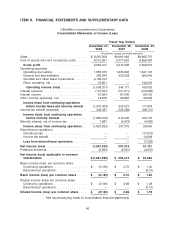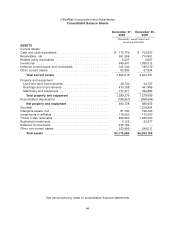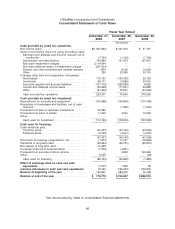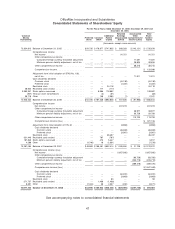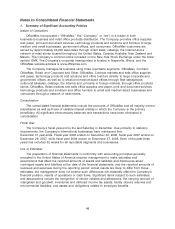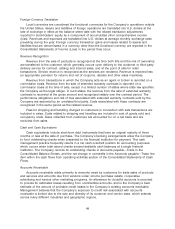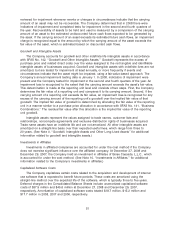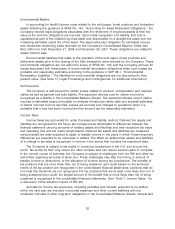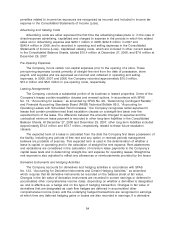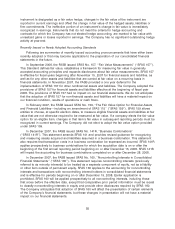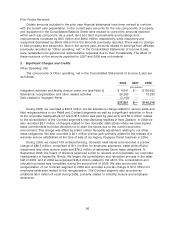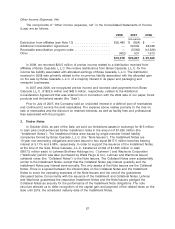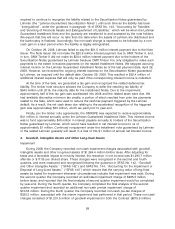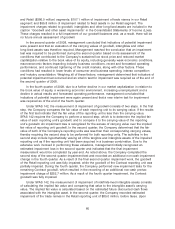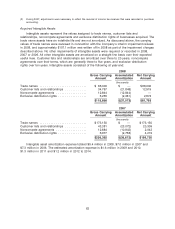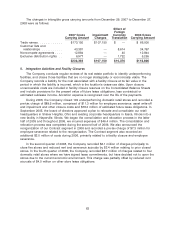OfficeMax 2008 Annual Report Download - page 57
Download and view the complete annual report
Please find page 57 of the 2008 OfficeMax annual report below. You can navigate through the pages in the report by either clicking on the pages listed below, or by using the keyword search tool below to find specific information within the annual report.Environmental Matters
In accounting for landfill closure costs related to the sold paper, forest products and timberland
assets following the guidance is SFAS No. 143, ‘‘Accounting for Asset Retirement Obligations,’’ the
Company records legal obligations associated with the retirement of long-lived assets at their fair
value at the time the obligations are incurred. Upon initial recognition of a liability, that cost is
capitalized as part of the related long-lived asset and depreciated on a straight-line basis over the
remaining estimated useful life of the asset. The asset retirement obligation for estimated closure
and closed-site monitoring costs recorded on the Company’s Consolidated Balance Sheet was
$4.2 million for both December 27, 2008 and December 29, 2007. These obligations are related to
assets held for sale.
Environmental liabilities that relate to the operation of the sold paper, forest products and
timberland assets prior to the closing of the Sale transaction were retained by the Company. These
environmental obligations are not within the scope of SFAS No. 143, and the Company accrues for
losses associated with these types of environmental remediation obligations when such losses are
probable and reasonably estimable according to the guidance in SOP 96-1, ‘‘Environmental
Remediation Liabilities.’’ The liabilities for environmental obligations are not discounted to their
present value. (See Note 17, Legal Proceedings and Contingencies, for additional information.)
Self-insurance
The Company is self-insured for certain losses related to workers’ compensation and medical
claims as well as general and auto liability. The expected ultimate cost for claims incurred is
recognized as a liability in the Consolidated Balance Sheets. The expected ultimate cost of claims
incurred is estimated based principally on analysis of historical claims data and actuarial estimates
of claims incurred but not reported. Losses are accrued and charged to operations when it is
probable that a loss has been incurred and the amount can be reasonably estimated.
Income Taxes
Income taxes are accounted for under the asset and liability method. Deferred tax assets and
liabilities are recognized for the future tax consequences attributable to differences between the
financial statement carrying amounts of existing assets and liabilities and their respective tax basis
and operating loss and tax credit carryforwards. Deferred tax assets and liabilities are measured
using enacted tax rates expected to apply to taxable income in the years in which those temporary
differences are expected to be recovered or settled. The effect on deferred tax assets and liabilities
of a change in tax rates is recognized in income in the period that includes the enactment date.
The Company is subject to tax audits in numerous jurisdictions in the U.S. and around the
world. Tax audits by their very nature are often complex and can require several years to complete.
In the normal course of business, the Company is subject to challenges from the IRS and other tax
authorities regarding amounts of taxes due. These challenges may alter the timing or amount of
taxable income or deductions, or the allocation of income among tax jurisdictions. The benefits of
tax positions that are more likely than not of being sustained upon audit based on the technical
merits of the tax position are recognized in the consolidated financial statements; positions that do
not meet this threshold are not recognized. For tax positions that are at least more likely than not of
being sustained upon audit, the largest amount of the benefit that is more likely than not of being
sustained is recognized in the consolidated financial statements. (See ‘‘Note 7, Income Taxes,’’ for
a discussion of the adoption impact of FIN 48.)
Accruals for income tax exposures, including penalties and interest, expected to be settled
within the next year are included in accrued expenses and other current liabilities with the
remainder included in other long-term obligations in the Consolidated Balance Sheets. Interest and
53


